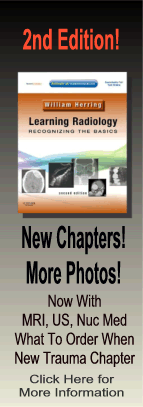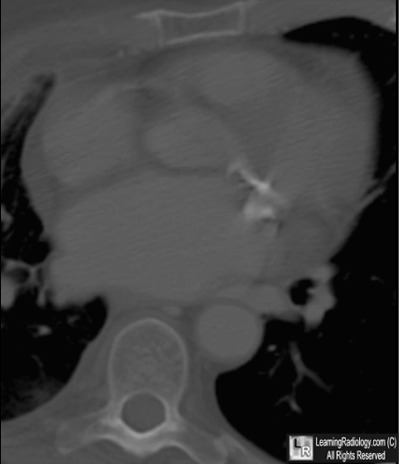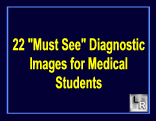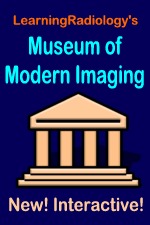| Cardiac | |
|---|---|
| GI | |
| Bone | |
| GU | |
| Neuro | |
| Peds | |
| Faculty | |
| Student | |
| Quizzes | |
| Image DDX | |
| Museum | |
| Mobile | |
| |
Misc |
| Videocasts | |
| Signs | |
Learning
Radiology:
Recognizing
the Basics
Available
on the Kindle
and IPad
LearningRadiology Imaging Signs
on Twitter
![]()
Follow us on
What is the most likely diagnosis?
- 61 year-old with increasing shortness of breath
- Aortic Stenosis
- Tetralogy of Fallot
- Tricuspid Atresia
- Tricuspid Regurgitation
- Mitral Stenosis
Additional Images - Axial CT Scan of Heart
![]()
Answer:
5. Mitral Stenosis
More (Click Discussion Tab)
Mitral Stenosis
General Considerations
-
Rheumatic disease causes mitral stenosis in 99.8% of cases
-
Acute rheumatic fever (ARF) → pancarditis
-
Mitral valve most commonly involved valve
-
Followed by mitral and aortic together
- Then by aortic alone
- Acute phase → cardiomegaly
MORE . . .
.
This Week
61 year-old with increasing shortness of breath |
Presented as a series of cards, this podcast asks some of the most common causes of neuroimaging findings and diseases making it ideal for a quick review. Can be used as either an audio only or audio/video podcast.; Complements Video Flashcard Podcasts 15, 21,25, 38, 42, 46 and 47. |
Some of the fundamentals of interpreting chest images |
The top diagnostic imaging diagnoses that all medical students should recognize according to the Alliance of Medical Student Educators in Radiology |
Recognizing normal and key abnormal intestinal gas patterns, free air and abdominal calcifications |
Recognizing the parameters that define a good chest x-ray; avoiding common pitfalls |
How to recognize the most common arthritides |
LearningRadiology
Named Magazine's
"25 Most Influential"
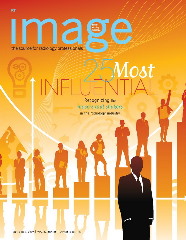
See Article on LearningRadiology
in August, 2010
RSNA News
| LearningRadiology.com |
is an award-winning educational website aimed primarily at medical students and radiology residents-in-training, containing lectures, handouts, images, Cases of the Week, archives of cases, quizzes, flashcards of differential diagnoses and “most commons” lists, primarily in the areas of chest, GI, GU cardiac, bone and neuroradiology. |

